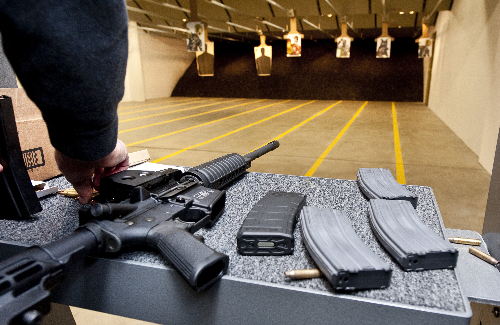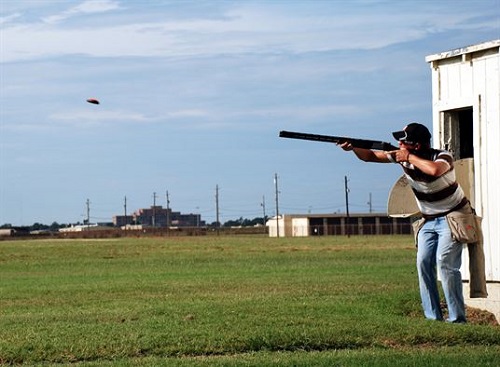
You must remember that even the smallest shot can kill a duck. Use smaller shots with care to avoid a fatality. A smaller shot can result in a better quality shot. Hevi-Shot is the best shot for this type. For larger birds, a #4 shot, 3 inches, is sufficient, while a #2 shot, 2 3/4 inches, is the best choice.
Shooting ducks using tungsten-steel pellets
Tungsten-steel pellets are powerful. Many hunters are forced to use this type shot when hunting tough sea ducks like Canadas. These pellets penetrate the bird deeper and kill it quicker than lead or steel bird shots. HEVI-Shot #4 pellets are an example of a good quality tungsten-steel duck load.

For ducks, steel shot is more effective
While steel shot does not produce as much energy as lead, it is still a very effective hunting ammunition. Steel shot is less dense than lead and tends to lose more energy. However, this disadvantage can often be overcome by using larger shot sizes. Many ducks look similar to pheasants. Lead shot users use No. 6 shot to capture them. No. 6 shot of steel shot is the most effective. There are 2 to 4 sizes of steel shot.
Geese love HEVI-Shot ammo
HEVIShot ammo offers both performance and affordability. The increased density of the pellet allows for smaller sizes which, in turn, increases pattern density. The pellet weighs more, which makes it difficult for geese that it folds up. Also, the pellet retains more energy and can be used at longer ranges. A heavier pellet can reach critical geese as far as 50 yards.
HEVI-Shot ammo puts the most shot on target
Popular choice for waterfowl hunter is the HEVIShot ammo. This lethal combination contains a three-inch shell and a one-and a quarter ounce load each of steel shot and 30 per cent bismuth shot. It is placed in front of the 70% steel shot. It can be loaded for long shots and leaves the barrel at approximately 1,500 feet per seconds. The USFWS has also approved HEVI-Shot for waterfowl hunting.
HEVIShot loads come in a variety of gauges
HEVI-Shot reintroduced tungsten waterfowl loads. HEVI-XII provides more power downrange as well as more pellets for target. HEVIXII pellets are non-toxic. They come in gauges ranging up to 20. HEVIXII pellets have a dense texture and a weight range of 7/8 ounces up to one and a quarter ounces.

Common mistakes made when shooting ducks
When hunting ducks, one of the biggest mistakes hunters make is waiting to shoot them when they are close enough. This can cause the duck to hit its tail feathers, or even the eye. When shooting a duck, the key is to focus and aim at the eye. By focusing on the eyes of the duck, you can shoot ahead and hit it safely. A second common error that duck hunters make when shooting ducks at night is not setting the right distance.
FAQ
Which state has more deer hunters than the other?
Wyoming is the state that has the most deer hunter's. It also sells the largest number of hunting licences each year.
South Dakota is the state that has the second highest number of deer hunters. It ranks third for the number of hunting licenses sold each year.
New Hampshire has the least number of deer hunters. It ranks last for the number of hunting permits per capita.
Is it possible to hunt without a licence?
Yes, hunting is legal without a license. But, you're breaking the law.
Fines and jail time could be possible.
Some states allow residents without a license to hunt. Check with your state department of natural resources to see if you are allowed to hunt without a license in your area.
Why is it that only 1% of hunters kill deer annually, according to the U.S. Department of Agriculture.
USDA estimates that about 6 million Americans hunt deer. Only 2.2 million of these people actually shoot deer.
This means only 0.6% of all hunters will kill a deer each and every year.
What's the popularity of hunting in America?
Hunting has become a beloved American pastime. Americans spend more than $8 billion each year on hunting supplies and equipment. The average hunter spends around $1,000 per year.
Hunting is also a sport for many people who do not hunt as a hobby but rather as a way to relax. It is estimated that the United States has nearly 50,000,000 hunters. This includes both men as well as women.
Hunters come in all walks of life. These hunters can range in age from children to seniors. While some hunters have been hunting for many years, others are just starting to hunt.
The most common reason why someone would want to become a hunter is that they enjoy spending time outdoors. Many hunters believe that hunting is a wonderful way to connect to nature and experience freedom.
Hunting can be an enjoyable social activity. Hunting groups often include hunters. These groups may include family members, close friends, colleagues, etc.
Hunting has been a very competitive sport. Hunting has become a competitive sport. Hunters compete against each other to see which species they can hunt.
Hunting teams compete to set the record for largest deer kill. These records are usually set up by professional hunters.
What is the most crucial part of hunting animals?
How do you get there? The first step is to learn how to shoot accurately. Next, you must learn how to hit your target. We must also learn to adjust when we miss our target.
Knowledge is key to hunting. If you don't know what you're doing, then you'll never improve. It might seem like you have improved because of your better shots. But if it wasn't so, those shots won’t make any difference. It's the same with hitting targets. If you don’t get why you’re not succeeding, you won’t be able to change. That means you need to know what you're aiming for.
Knowledge is key. Your ability to hunt is dependent on your knowledge of the animal that you're hunting. You want to learn as much about the animals that you see while you are out in nature. It is important to understand their habits, behaviors, and personalities. So you can plan your hunts smoothly and efficiently.
Learn from those who have succeeded in the past. There are many books that can be found on this subject. In addition, there are websites like www.thehuntingzone.com that offer great tips and advice. You can also find people with years worth of experience. They will be able to help you understand what works and not.
Once you've learned everything you can, it's time to practice. Practice makes perfect. However, you shouldn't just practice until you feel good. Instead, you should practice until you become confident. Confidence helps you relax and enjoy the process. Relaxation allows you to focus on the task at hand. Concentration is key to maximizing every opportunity. Opportunities will only appear if you are calm and focused.
You're now ready to test your new skills. Don't worry if you fail. Don't worry if you fail. Just keep practicing. Eventually, you'll find success.
Statistics
- Licenses dropped from a peak of roughly 17 million in the 1980s to 15 million in 2019, according to The Seattle Times. (stacker.com)
- - Percent of residents with paid hunting licenses: 0.7%- (stacker.com)
- Indiana, for example, saw a 28% jump in turkey license sales during the first week of the season. (stacker.com)
- According to the Wildlife Restoration Act, passed in 1937, most of the state conservation efforts are funded through hunting and fishing license sales and firearms sales. (stacker.com)
External Links
How To
How to hunt wild hogs
Large animals, wild hogs can be found across North America, Africa and Asia. Wild hogs can eat small animals and plants, including birds, insects and rabbits. They usually feed at night. The gestation period lasts around six months, after which one piglet is born. A sow has one child every two years. Wild hogs are solitary animals, although they sometimes live together in groups called herds.
Wild boars typically weigh around 200 pounds (90kg). Their head length is between 10 and 12 inches (25-30cm), while their body length is between 20 and 30 inches (50-60cm). Wild pigs have long legs, broad shoulders, and short tails. A thick layer of fat is found under their skin.
They have excellent senses of smell and hearing. These senses are used to find food and detect danger. They can run up to 35 miles per hour (56 km/h) and jump distances of up to 15 feet (4 m). They have sharp teeth and claws. They are strong and aggressive in defense against predators.
Hunting wild Hogs can be difficult as they are agile, intelligent, and elusive. Hunting wild hogs is a dangerous business. Hunters should not shoot too quickly. The animal might escape. Hunters who shoot too soon can kill the animal before it reaches cover.
There are many methods of hunting wild hogs. The most common method is shooting. Hunting requires that the animal be tracked down and then waited until it is within range. Another method is trapping. Setting traps near water sources is another method of trapping. Traps often include a scent lure like corn meal mixed with peanut butter. When the trap is opened, the hunter shoots a trapped pig.
Snaring, another method, is also an option. Snaring is a method that uses a noose of rope to catch the pork. It is best to catch the pig during its mating season.
Other options include poisoning or spearing. For a pig to stop breathing, netting or spearing involves putting a net or spear around its neck. Poisoning can be done by injecting poison into the body of the pig.
Hunters who want to hunt wild hogs must be ready for cold temperatures. In some areas, hunters wear snowshoes to keep warm. Some hunters bring dogs with them to help them track the animals.